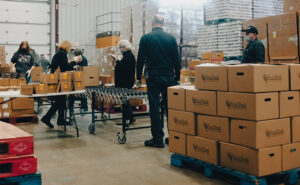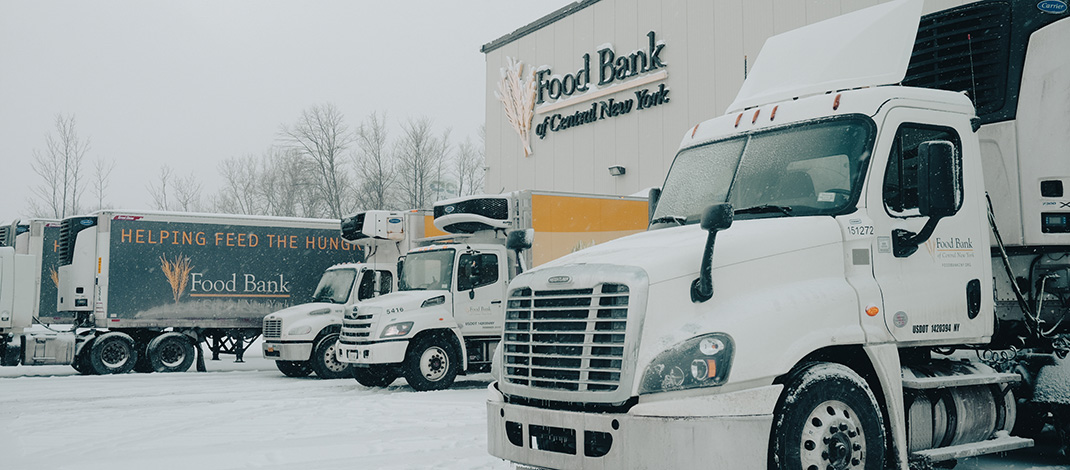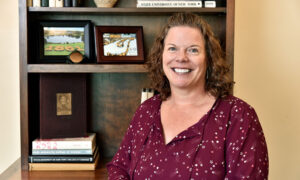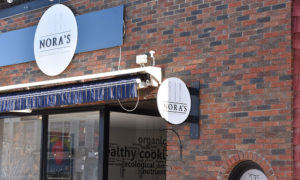Nonprofit is in the midst of an $8.5 million expansion of its distribution and office complex in Syracuse. It will be able to store an additional one million pounds of food
By Norah Machia

The Food Bank of Central New York has started an $8.5 million major expansion of its distribution and office complex in Syracuse to continue helping an increasing number of people facing hunger in Onondaga and many other surrounding counties.
Site work began in April to expand the nonprofit organization’s building on Interstate Island Road from 74,000 square feet to 108,000 square feet.
“This expansion will allow us to help many more individuals and families” in the 11 counties served by the agency throughout Central and Northern New York, and the Mohawk Valley, said Lynn Hy, chief development officer.
Started in 1985, the organization operates a large food warehouse distribution center in Syracuse, where food is sorted, packed and then loaded for distribution on the agency’s fleet of 15 trucks equipped with refrigeration units.
Although some renovations were completed when the agency first purchased the facility in 2010, “we never expanded the footprint of the building,” Hy said. The building project will enable the Food Bank of CNY to expand its operations in three major areas.
The expansion project will provide significantly more storage space, enabling the food bank to store an additional one million pounds of food. This will help the Food Bank of CNY increase the distribution of emergency food packages and help secure other items that are often difficult for those dealing with food insecurity to access, such as hygiene supplies, Hy explained.
The additional warehouse space will help reduce waste by allowing food bank staff and volunteers to process and distribute donated perishable food more efficiently. It will also increase the capacity of the Food Bank of CNY to supply specialty food boxes to accommodate dietary, cultural and health-related needs, she said.
VIP Structures, a Syracuse-based design-build firm, is completing the major expansion project, along with many other local trade businesses. The project is expected to be finished in May 2024.
Serving more than 400 emergency food programs and covering a 12,334-square-mile region, the Food Bank of CNY is one of 10 food banks established in New York state to support independent food pantries operating in various locations. An estimated 162,160 individuals face food insecurity within the Food Bank of CNY’s service area.
“We need to get the food to where people who are experiencing hunger are living, so they don’t need to leave their communities,” said Hy. A lack of transportation is often a significant barrier for people to access healthy food, she added.
Although most food pantries were initially set up for emergency use, more people have been using them for ongoing support, said Hy.
“People experiencing hunger come from all walks of life,” she said. “They are often just one crisis away from relying on this food network. It could be an unexpected medical bill or a car that breaks down.”
Food pantry use increased even more during the COVID-19 pandemic. “People who lost their jobs were suddenly thrown into food insecurity and some have still not found work again,” Hy said. “The emergency food pantry has become an essential component of their lives.”
“We’re always looking at common trends, how is the face of hunger changing, how can we meet people’s needs?” she added. “Not everyone has a full kitchen. Some may only have a microwave to cook and may not own a freezer for storage.”
The United States Department of Agriculture Food Commodities program is one of the primary sources of food products for the nonprofit agency. The Food Bank of CNY also receives donated food from manufacturers, distributors and retail partners, and purchases bulk foods directly from wholesalers.
Farmers throughout the region provide the primary sources of fresh produce, with the food bank purchasing more than 3 million pounds from New York state growers. “We work with a produce distributor, and they work with the farmers to box up and deliver the food to our warehouse,” Hy said. The Nourish New York program, started during the COVID-19 pandemic, continues to provide additional funding for fresh produce purchases.
“Even before this program, we were working to distribute fresh produce,” she said. “But this really allowed us to expand and provide more jobs for New York state residents.”
The Food Bank of CNY also does outreach programs to help promote self-sufficiency, including distributing “Garden on the Go” kits containing 20 root pouches with assorted seeds and seedlings to families wanting to grow fresh produce.
“These are designed for people who don’t have access to land where they live,” Hy said. “They’re offered through our partner agencies and can be used to grow plants in places such as window sills.”
Food Bank of CNY educators offer various nutrition education programs, and travel to food pantries, shelters, soup kitchens and farmers’ markets for cooking demonstrations.
Because “food is just one component of why people are in need,” New York state also funds the food bank to provide Supplemental Nutrition Assistance Program (SNAP) outreach, Hy said. When meeting with potential SNAP-eligible families and individuals, the outreach teams can offer referrals to other support services such as the Women, Infants and Children (WIC) and the Home Energy Assistance (HEAP) programs for clients in Onondaga, Cayuga, Jefferson, Lewis and Oswego counties.
The $8.5 million project is being supported with a combination of federal and state funds, along with corporate and individual donations. The federal funding for the project was obtained with support from Senate Majority Leader Charles Schumer, Senator Kirsten Gillibrand and former Representative John Katko. Support on the state level was provided through the New York State Regional Economic Development Council and the State and Municipalities Facilities (SAM) grant program with the assistance of Senator John Mannion.
Private donors include Wegmans Food Markets, the Syracuse St. Patrick’s Hunger Project, Giovanni Foods, the Central New York Community Foundation and several other generous individuals. Additional donations are still being sought to fund the project fully.
For more information: www.foodbankcny.org




